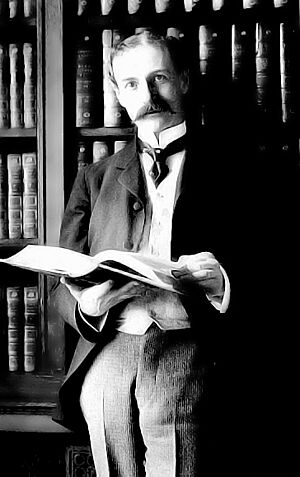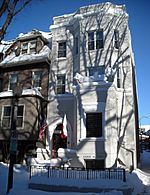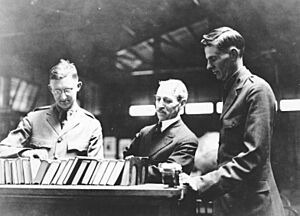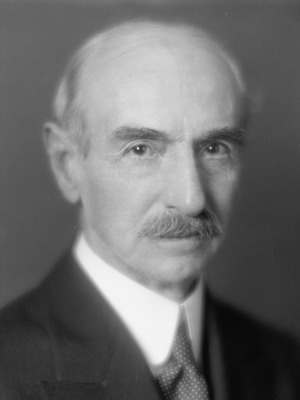Herbert Putnam facts for kids
Quick facts for kids
Herbert Putnam
|
|
|---|---|

Herbert Putnam
|
|
| Librarian Emeritus of Congress | |
| In office 1939–1954 |
|
| Preceded by | Office established |
| Succeeded by | Office abolished |
| President of the American Library Association | |
| In office 1903–1904 |
|
| Preceded by | James Kendall Hosmer |
| Succeeded by | Ernest Cushing Richardson |
| In office January 1898 – August 1898 |
|
| Preceded by | Rutherford P. Hayes |
| Succeeded by | William Coolidge Lane |
| 8th Librarian of Congress | |
| In office 1899–1939 |
|
| President | William McKinley Theodore Roosevelt William Howard Taft Woodrow Wilson Warren G. Harding Calvin Coolidge Herbert Hoover Franklin D. Roosevelt |
| Preceded by | John Young |
| Succeeded by | Archibald MacLeish |
| Personal details | |
| Born |
George Herbert Putnam
September 20, 1861 New York City, US |
| Died | August 14, 1955 (aged 93) Woods Hole, Massachusetts, US |
| Spouse |
Charlotte Elizabeth Munroe
(m. 1886) |
| Children | 2, including Brenda |
| Parent |
|
| Alma mater | |
| Awards |
|
| Signature | |
George Herbert Putnam (born September 20, 1861 – died August 14, 1955) was an important American librarian. He was the eighth Librarian of Congress, serving for a very long time from 1899 to 1939. During his time, he worked to create a huge collection of books and materials in many languages, especially from Europe and Latin America.
Contents
Biography
George Herbert Putnam was born in New York City. He was the tenth child of Victorine and George Palmer Putnam. His father, George Palmer Putnam, started a famous publishing company called G. P. Putnam's Sons.
In 1886, Herbert Putnam married Charlotte Elizabeth Munroe. They had two daughters, Shirley and Brenda Putnam. Brenda grew up to be a well-known sculptor in the early 1900s. She was famous for her sculptures of children and garden decorations.
Herbert Putnam passed away at his home in Woods Hole, Massachusetts, on August 14, 1955.
Early Career in Libraries
After finishing his studies at Harvard University in 1883, Putnam spent a year at Columbia University Law School. But he was more interested in managing things. This led him to become a librarian at the Minneapolis Athenaeum in 1887.
When the Athenaeum joined with the Minneapolis Public Library in 1888, Putnam became the city librarian. He also became a lawyer in Minnesota at the same time. He made many improvements to the library. He updated old systems, created new ways to organize books, and let readers go into the book areas. He believed libraries should help people find books and also encourage people to read. He even helped create the Putnam Classification System for organizing books.
In 1891, Putnam moved back to Boston. He practiced law there until 1895. Then, he was chosen to be the Librarian of the Boston Public Library. During his four years there, the library grew a lot. It added more branches and reading rooms. He also added a special room just for children, which was one of the first in a large library in the country.
Leading the Library of Congress
Becoming the Librarian
Herbert Putnam played a big role in expanding the Library of Congress. He helped convince Congress to make the library much bigger and more important. This change happened in 1897.
Because of his work with the American Library Association (ALA), Putnam became a delegate to an international meeting of librarians in London in 1897. After the ALA President, Justin Winsor, passed away, Putnam finished his term. In 1899, President William McKinley asked Congress to appoint Putnam as the new Librarian of Congress. He officially started on December 12, 1899.
Organizing a National Treasure

When Putnam became Librarian of Congress, he faced a huge job. The library had just moved into the new Thomas Jefferson Building. There were tons of materials that needed to be organized so people could use them easily.
Putnam asked Congress for a lot more money to help with this task. He said the library needed more books and better ways to organize everything. Congress agreed and gave him the funds.
His team worked hard to collect, organize, and share all the library's materials. They were very successful! By 1924, they had:
- Organized all the different areas in the building.
- Put special materials in the right places.
- Created a new, flexible system for classifying books.
- Set up standard ways to catalog books for all American libraries.
- Applied these new systems to most of the book collection.
Putnam also started the Library of Congress Classification system, which is still used today. He also created a system where libraries could borrow books from each other, called interlibrary loan. This helped the Library of Congress work better with other libraries.
Helping During Wartime
In 1916, someone suggested that the Library of Congress should send books to American soldiers. At first, Putnam wasn't sure. But when he saw that British libraries were doing something similar for their troops, he changed his mind.
Putnam, the ALA, and Congress quickly worked together to start a program for American soldiers. With money from the Carnegie Corporation, they built 36 libraries for soldiers. They also asked ALA members to donate books and volunteer. By June 1918, they had bought hundreds of thousands of books and sent millions of donated books and magazines to military camps.
The Library of Congress's help during World War I showed everyone what a national library could do. It gave librarians a new idea of how important their work was.
Retirement
Herbert Putnam was the Librarian of Congress for 40 years, from 1899 to 1939. He didn't want to leave the world of libraries completely. So, he suggested a new title for himself: "Librarian Emeritus." This meant he would still be involved and receive half of his old salary.
On October 1, 1939, Putnam retired with this new title. He continued to work at the Library of Congress for another 15 years, keeping regular office hours.
In 1940, he was given an American Library Association Honorary Membership.
Archibald MacLeish took over as the Librarian of Congress after Herbert Putnam in 1939.



